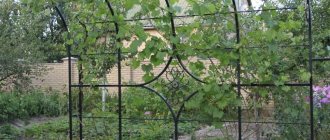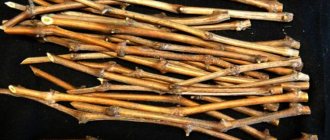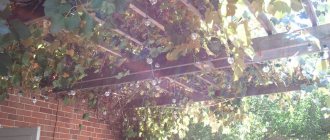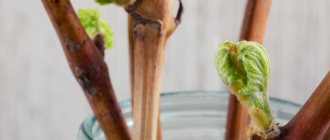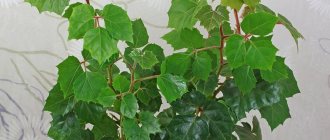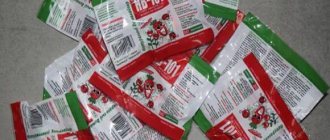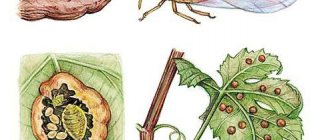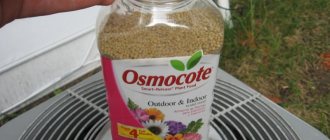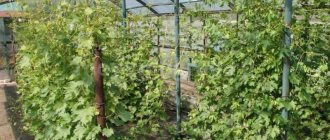It’s easy to grow a grape seedling yourself; you don’t need any special conditions or equipment for this. Even a beginning winegrower can fully provide himself with planting material during the warm season without any financial investment.
Growing seedlings with your own hands is convenient and profitable in all respects:
- Varietal chibouks cost a mere trifle compared to ready-made planting material.
- Rooting cuttings allows you to obtain a viable seedling in early summer, while cuttings in open ground only in September. In fact, in 1 season the cutting manages to go through a 2-year cycle and begins to bear fruit 1 season earlier.
- The winegrower is not tied to seasonal supplies of planting material to the market - he has the opportunity to independently and completely free of charge grow any number of seedlings of excellent quality.
- After autumn pruning of the vines, you can get so many shanks that they are enough even for the production of seedlings on an industrial scale.
The useful ability to grow planting material with your own hands will always be useful for repairing, expanding or starting a new vineyard.
A little theory that an ordinary summer resident cannot do without
All the rules for cutting vines for harvesting chibouks have a scientific basis. Without a clear understanding of the structure of the vine, cutting cuttings turns into a set of sequential monotonous actions to fulfill strict and completely incomprehensible requirements.
All operations for harvesting grape cuttings will seem simple and understandable if you understand the structure of the vine segment. Nodes and internodes - the entire grape vine consists of them.
The easiest way is with internodes . Their main purpose: transit of nutrients and water, by analogy with human blood vessels. The outer cover (bark) protects the wood from damage and moisture loss. Under the bark is the cambium , a thin layer of tissue responsible for regeneration processes. If we continue to draw analogies with the human body, cambium is an analogue of stem cells, which, under certain conditions, give rise to any organ. In the case of grape propagation, it is the cambium cells that develop into the root system of the seedling.
For the successful transformation of cambial tissues, a supply of nutrients and moisture is required. in the core , which support vital processes during winter storage and feed growth processes during rooting.
The second mandatory component responsible for metabolic processes is water. The distribution of water reserves in the vine (and the cut cuttings) depends on the nodes, which can be simply described as a regular membrane.
There are 2 types of nodes (see picture):
- The core channel is blocked to a large extent - the outflow of nutrients is significantly slowed down. Most nodes on vines are of this type. They are responsible for the outflow of nutrients at the end of the season from the leaves to the roots and sleeves.
- The internode forms an almost blind membrane, which maximally retains the flow of water and nutrients. Type 2 knots on the vine are easy to find - just find a knot with a tendril .
The most promising units for preparing pipes can be easily determined by eye:
- evaluate the difference in the thickness of the vine and the diameter of the node and select a section of the vine according to the principle “the thicker the node, the stronger the growth bud”;
- For the lower (heel, root) part of the cutting, select nodes with remnants of a tendril, i.e., with a developed internal partition.
After such a “lyrical digression,” there should be much fewer questions about the rules for cutting cuttings.
How to properly prepare future seedlings?
The main question that experienced winegrowers are asked about grape cuttings is: “How do you store planting material during the long winter in order to get healthy shoots in the spring?”
There are a few things to consider here. It is best to harvest the chibouk in late September or early October (adjustments are made depending on the weather). At this time, the vital activity of the plants decreases, and pruning will cause less harm to the grapes. Since branches preparing for winter lose most of their moisture, it is necessary to partially replenish its reserves before storage. This is done quite simply: all the leaves and tendrils are removed from the cut cuttings, a fresh cut is made in its lower part, and the stem itself is placed in water (preferably rain or melted water, but always clean) for about a day. This procedure will protect the twig from drying out, and it will safely survive the winter. You can additionally dip the sections on both sides in warm paraffin - this will prevent the rapid evaporation of moisture from the trunk.
Someone additionally makes several light longitudinal grooves up to 3 cm long on the bottom of the chibouks to ensure additional development of roots in the spring.
It is recommended to moisten the prepared cuttings in iron sulfate (a few seconds is enough), and if it is not available, in a slightly colored solution of potassium permanganate, quinozol or foundationazole, then dry well. This treatment will help fight mold and various diseases.
Comparison of grape cutting methods: choose simple and reliable
Gardeners of the Central region are accustomed to autumn planting, which invariably shows good results in the survival of fruit seedlings in the month of September. Currant cuttings are traditionally planted in greenhouse “schools” in late autumn in order to obtain a strong young bush during the season.
Unfortunately, the benefits of autumn rooting do not apply to grape seedlings. The result does not live up to expectations - the yield suitable for further cultivation is unpredictable (no more than 20%).
Reason 1
The cutting must go through a period of rest - the tissues responsible for the development of roots and fruit vines must ripen within 3-4 months. It only seems that the cuttings “sleep” in winter. In fact, unhurried metabolic processes are taking place: the rudiments of all plant organs are developing. Without this phase it is impossible to obtain a strong seedling.
You can try to hurry up nature and root green grape cuttings in the summer. Be prepared to spray daily, monitor temperature and light conditions. The slightest miscalculation and violation of the regime leads to rot or drying of plants. Even if everything worked out, the cutting took root and began to grow, it is strictly forbidden to plant it in open ground.
Reason 2
The vines of an adult bush easily tolerate frosts of -15...20 degrees (some varieties - up to 35). The root system dies at -10...12 degrees. Rooted cuttings are planted to a depth of 20...30 cm. The young seedling is doomed - its roots freeze out, the plant will not survive until spring.
Interesting fact
Winegrowers of the southern regions, despite the relatively warm autumn and winter, prefer to root chibuki in the spring at home in cups or a little later - in shkolkas. The experience of many generations confirms that such chibouks easily form roots and shoots, and in the summer they are completely ready for planting in a permanent place.
The only requirement: high-quality cuttings are needed - cut on time, properly stored and prepared for rooting. Autumn planting of cuttings in a schoolhouse does not give guaranteed results even in the Southern region
What and when to do with germinated cuttings
Sprouted chibouks are planted in the spring, when 2-3 true leaves have formed on the seedling. First, water the container with grapes and remove the shoot. Before burying, the roots are immersed in a clay mash. Honey water is also used for processing, which is prepared from 1 liter of water and 1 spoon of honey. The planting process is completed by burying the cutting and installing a stake as a support. It is recommended to mulch the soil around the bush.
After germination, the chibouks are planted in the ground and then transplanted to a permanent place of residence.
Planting chibuks in the spring is characterized by a high survival rate of the material (up to 95%). Such a plant can bear fruit as early as next year. The timing is determined by weather conditions; night temperatures should not fall below 0°C.
There are many ways to prepare and store cuttings, and you can easily choose the most suitable one. Then there will be no need to worry about loss of variety as a result of freezing of the vine. During the warm period, the seedling will gain strength and become stronger, which will help it survive the harsh winter under reliable shelter. And then it can be germinated and propagated.
Harvesting cuttings
To cut cuttings, you need to prepare a sharpened pruner.
In the case of harvesting chibouks from bushes of different varieties, be sure to prepare waterproof tags in advance.
When to take cuttings
Grape chubuks are harvested only after the vines have ripened: late in the fall - during the period from leaf fall to frost. By this time, the cuttings have accumulated the maximum amount of winter reserves: photosynthesis products, various sugars.
Geographically, the timing of autumn pruning varies greatly. In the Central region this may be the end of October, in the south - November or even the first days of December.
It is much easier to navigate not by calendar dates, but by weather signs that exactly correspond to the biorhythms of plants.
Helpful advice
It is better to be late with pruning grapes than to rush and trim the bushes too early.
On time - at the first signs of winter:
- steady weather with night frosts;
- daytime temperatures are just above zero degrees;
- thin ice in the morning along the edge of the reservoir, etc.
For pruning vines and harvesting shanks, you should choose a dry, clear day.
How to properly cut vines into cuttings
Even in the summer, the best bushes for propagation should be noted: in terms of yield, presentation of the bunch, size and taste of the berries. It is best to harvest the stems in parallel with pruning, immediately setting aside promising sections of the vine separately.
Unripe tops are cut off immediately.
- A mature vine is easy to determine literally by touch : in addition to the characteristic crunching sound when bending, the mature area seems warm compared to the cool, unripe top of the vine.
- For cuttings, vines from 8 to 12 mm in diameter are suitable : those that are too thin take root worse and produce weak, sickly seedlings; thick “fatty” shoots are unsuitable for another reason: their underdeveloped “eyes” practically do not form fruitful branches.
- For the lower (heel) part of the cutting, choose nodes with a tendril - such cuttings take root much better.
The lower 1/3 of the vine is considered the best for cutting pipes. This area always has time to ripen well and contains the maximum amount of nutrients. Ideally, it is advisable to put this entire segment for storage.
On a large farm with a large vineyard, it is justified to leave such long cuttings for winter storage. They are buried in a trench. At home, especially in a city apartment, you have to shorten the vine sections to a reasonable size :
3-4 buds + at least 1/2 the length of the internode.
Even when cutting 2 varieties of grapes, the cuttings should be labeled. The shade of the bark can change during storage, and all sorts of “memory nodules” after 3-4 months only cause bewilderment.
When is the best time to take cuttings?
People who are far from growing grapes believe that it is best to cut chibouks in the spring. But this opinion is wrong, because until next year the material will simply rot or dry out. If the cut cutting is immediately inserted into the ground, without allowing it to overwinter in conditions suitable for storage, it will quickly dry out and not even take root. In addition, a wound will remain on the “operated” vine, which will become a gateway for the invasion of grape pathogens. It turns out that it is better to save the cuttings cut in the fall than to spoil the material and waste time.
The shoots are harvested in October, when the processes of vegetation and sap flow in the bushes are suspended. The cuts heal over the winter, and the injured cambium vessels become clogged. Before the beginning of spring, the plants are restored, and the summer resident does not have to worry about their infection.
Petioles are cut from healthy and mature annual vines. The readiness of a plant for reproduction is checked in two ways:
- Branch bend. A sufficiently developed branch produces a slight crackling sound.
- Iodine treatment of the cut. The stalk is cut off, and its former location is smeared with iodine. If the vine is mature, the cut quickly turns black.
Shoots that are too thin or thick are not used for propagation. Such planting material is considered to be of poor quality. It is optimal to cut cuttings from the middle part of the shoot, which over the summer has managed to accumulate reserves of useful substances for wintering in natural conditions. The thickness of the shoots should be 5 - 8 mm. If all conditions for harvesting grape cuttings are met, the chances of rapid rooting and survival of young plants increase significantly.
What determines the preparation of cuttings for storage?
Already on the day of pruning, you should deal with the delayed cuttings. Left outdoors, they immediately begin to lose moisture, so valuable for planned rooting.
The optimal way to store harvested vines is in a trench, where they will definitely not dry out or rot. In the Central region, during winter, at a depth of 60...70 cm, the temperature remains around 0 degrees.
For colder regions, rotting organic matter is placed on top of the trench to prevent soil freezing. This method is good for everyone, except for one thing - until the soil thaws, it is impossible to remove the cuttings.
So it turns out that the method of storing grape cuttings depends on how soon they will be needed in the new season.
- For the needs of a large vineyard, a large number of cuttings are prepared, which, when warmer weather arrives, are planted in a schoolyard. Such cuttings are most often stored buried in a trench, where they definitely will not dry out. It is quite enough to disinfect the vine sections with vitriol.
- Owners of small vineyards often store material for propagating grapes in the basement or cellar. Some of the cuttings wait until it gets warmer, others are taken out in February and rooted to produce a full-fledged seedling by the beginning of summer.
- Summer residents usually harvest cuttings in small quantities and store them in the refrigerator or cellar. It is important for gardeners to be able to monitor the condition of the vine during storage and take appropriate measures if necessary. To obtain seedlings early, rooting begins in winter, in February.
Let's look at how to properly prepare cut vines for storage at home in more detail.
Soak
Here opinions differ. Some believe that if you soak the cuttings, this will prevent drying out and the quality of the cuttings will be high. Others say that pre-soaking causes rot. Therefore, decide for yourself here, but I still like to check both opinions and draw my own conclusions.
Prepare a large container. Pour in clean water. Dip the cuttings there so that they are half submerged in water. There is no need to completely submerge.
The vines should be moistened after treatment with disinfectant solutions. (I will write about this below). If you do not soak the chibouks immediately after trimming, then you will need to trim the sections again later so that moisture can enter them.
They should lie in cold water for 1-2 days, then they should be wiped dry and allowed to lie down to dry.
If you do not treat the cuttings against diseases and microbes, then preserving healthy stems until spring is impossible. Because During storage, the microenvironment is very conducive to the development of microorganisms and pathogens in them.
Methods for disinfecting cuttings:
Disinfection is an important step.
Firstly, you can treat the rootstocks with a solution of weak potassium permanganate. Too strong a concentration can harm the cuttings. We immerse the chopped vines completely, but for no more than 30 minutes. This time is enough to get the desired effect.
Secondly, you can treat it with a solution of copper sulfate. Concentration per glass of water (250 ml) add 1 tsp. copper sulfate. It is enough to spray with this composition. There is no need to put it in the solution.
Thirdly, you can purchase ready-made special preparations in stores that reduce pathogenic microflora. These are drugs such as Rovral, Topsin-M. You can also use "Ronilan". It must be diluted according to the instructions.
Preparing pipes for storage
All the troubles that can happen to cuttings during winter storage are associated with excess or lack of moisture:
- if there is a deficiency, they will dry out;
- if there is an excess, they will rot or die from a fungal disease.
When stored in an accessible area (cellar, basement, refrigerator), the lack of moisture can be easily corrected. For example, compensate by spraying. But remember! That waterlogging is much more dangerous for cuttings, because... this threatens the development of rot and fungal diseases, which are much more difficult to cope with. Diseased cuttings will be of no use.
Online and printed publications strongly recommend “soaking” harvested vines in cold water for 2 days. This necessary precaution is intended to restore the water balance of cuttings that have already dried out for a day or two. Freshly cut vines do not require additional soaking before storing.
“It’s easier to prevent a disease” - a common phrase about prevention is ideal for plant diseases. Treatment with 3% copper sulfate will help cope with dormant fungal spores.
- Copper sulfate does not dissolve well in cold water, so to prepare an effective solution, you need to pour 30 g of copper sulfate (2 tablespoons) with 1 liter of hot water and wait until the solution cools to room temperature.
- It is enough to immerse the cuttings in the solution for 15-20 seconds, this will be enough to prevent such a dangerous fungal disease as mildew.
- Long cuttings are treated sequentially on both sides if it is not possible to disinfect in one go.
After such treatment, the pipes should be left in the open air to wait for the remaining water from the disinfectant solution to evaporate.
, waxing of cuttings is also used . The ends of the pipes are momentarily dipped into paraffin melted in a steam bath with the addition of garden varnish: for 1 candle, add about 1 teaspoon of varnish, which gives the mass plasticity.
A thin layer of melt instantly forms a protective waterproof film. You can use both white and colored paraffin for decorative candles.
Attention
Only completely dry cuttings can be waxed. Random moisture or plant juice from an undried cut is a breeding ground for the proliferation of microorganisms. Checking the condition of the cuttings once every 2 weeks during the winter is a sufficient measure to control humidity.
Preparing for storage in the cellar or refrigerator
The preparatory process involves saturating the chibouks with moisture so that they do not dry out during the wintering period. To do this, cut shoots are immersed in a container of water and kept in it for 24 hours. After this, the planting material is disinfected in a solution of potassium permanganate for 30 minutes.
Instead of potassium permanganate, you can use 3% copper sulfate. The cuttings treated in this way are dipped in a paper towel and laid out on paper to dry.
Proper preparation increases the chances of preserving the planting material. The workpieces should be stored tightly wrapped in film in a cool place.
Before storage, the chibuki must be saturated with moisture.
Storing cuttings
Depending on the planned method of obtaining seedlings and the real capabilities of the vineyard owner, the optimal method of storing the chubuks is chosen. Let us dwell on the recommendations for amateur gardeners. There is no point in digging trenches to store several dozen chibouks harvested for repair or expansion of the vineyard.
There are simple and affordable methods that allow you to periodically check the condition of the vine, and start growing seedlings on the eve of spring.
Basement, cellar
A dark, cool place without temperature changes is ideal for wintering chibouks.
For the basement/cellar there are 2 simple ways to store cuttings
Gardeners practice the “in the sand” method in 2 variants:
- In a spacious box, the cuttings are placed horizontally and sprinkled in layers with a large amount of slightly damp sand. It turns out to be an analogue of storage in a trench.
- Most often, bulky dishes (buckets, pots) are filled with raw sand and the pipes are stuck in with the heel down.
In a refrigerator
The lack of a cellar is not a reason to refuse to harvest cuttings for the winter. Even in a small kitchen refrigerator there is always room for cuttings.
The optimal temperature for storing pipes is +2...+6 degrees, on the bottom shelf or vegetable compartment of the refrigerator.
Depending on the capacity of the refrigerator, gardeners practice various options for packaging cuttings - in polyethylene, PET bottles, etc.
Any of these methods requires mandatory monitoring of the condition of the cuttings. You need to check your bookmark at least 2 times a month. Both excess moisture and drying out are detrimental to cuttings.
Where to store cuttings in winter
Consider the most common effective and optimal places for storing grape cuttings in winter.
In a refrigerator
As a rule, the vine is cut to 40 cm for storage in the refrigerator, because Refrigerator size is limited. One of the disadvantages is also storing a limited amount of vines. However, the storage temperature and condition of the pipes are always under control.
The vine is wrapped with a material of natural composition. Moreover, you need to wrap no more than half of the cutting. Then they put a PE bag on top, the ends need to be left out a little so that they peek out. This is done to prevent rot from developing on the vine and infecting the remaining cuttings.
For prevention, you need to treat the vine monthly in a light solution of potassium permanganate.
Synthetic fabric is not suitable.
In the cellar
The room must be dry and not susceptible to freezing in severe frosts. However, an important condition is the ability to regularly ventilate the cellar or basement to prevent the formation of fungal infections and mold.
Most often the vine is laid out in a vertical position. You can use a shallow container, pour about 10-15 cm of sand into it, and lightly moisten it with water. Then the chibouks are stuck into the sand, as in their position in nature, without turning them over. Maintain a distance between the cuttings so that they do not touch. Check the moisture content of the sand every month and moisten it. Control the top of the vine.
The next method of storing cuttings in the basement is the horizontal arrangement of the pipes. To do this, the vine is laid in layers, sprinkled with sand or moss. It is also necessary to control moisture; for this you need to inspect the container and, to preserve and retain moisture, it is advisable to cover it with PE film on top. Also monitor the condition of the cuttings for any rotting.
During the storage period, you need to change the position of the upper shanks to the bottom twice, and the lower ones to the top.
"Bulgarian" storage method
This method involves storing the cuttings in water. Clean water up to 4 cm is poured into the bottom of the container. Here the winegrower must constantly monitor the process. Because water will be regularly consumed by the cuttings and evaporate and must be constantly added. During winter, you need to completely replace the water once.
Storing in river sand at home
River sand contains many microbial parasites. Therefore, before using this material, it must be calcined. This will help reduce risks to a minimum. We tie the prepared grape vines into bunches of up to 8 vines. We spread the bottom layer with sand and arrange the bunches on it.
We moisten the bottom layer in advance. After this, fill it with a second layer of sand and moisten it a little. The sand will have to be soaked sometimes, because... it dries out. This is done when removing the pipes from the box.
Storing grapevines in snow
Regions where snow falls from autumn to spring can use this method. After all, inside the snow there is a minimum positive temperature, which allows you to preserve the chibouks.
For this you need PE bottles. They will prevent excessive wetting and freezing of the vine. For each bunch of chibouks you need to prepare two bottles. The length of the pipes should fit into the bottle.
Cut off the bottom of both PE bottles. We put a bottle on both sides of the bundle and seal it, one into the other. To prevent diseases and maintain humidity, you can put a sterile cloth or bandage soaked in a solution of potassium permanganate inside. Closing the bottles
The snow must be compacted and at least 10 centimeters high. Bottles are placed on this “pillow” and snow is buried on top. The length of the vine with this storage method is usually about 40 cm.
“Cases” with chibouks are laid out evenly on it. The bottles are covered with snow as carefully as possible. For this method, only chibouks no larger than 40 cm are suitable.
Storing cuttings in a trench or special pit
For this method you need to choose the right location. It should be mostly in the shade and without stagnant water. Those. have a good slope or drainage. A trench is dug 90 cm. To prepare it, you need to have slaked lime and river sand (calcined). We will treat the edges of the pit with lime to disinfect micro infections and parasites. If the sand is not calcined, mold will grow in it.
Photo used as illustration. Source Yandex pictures
We lay a compacted layer of sand on the bottom. We lay out the vine. We again cover the top with a layer of sand and then snow. This will allow you to maintain optimal temperature conditions.
Storing cuttings in pots or buckets of soil
The method of storing cuttings in a trench is similar, but with this method the vine is under the supervision of the winegrower and constant control.
Cut grapes are placed in large buckets, containers, etc. and lay the soil as fluffy as possible. The advantage of the method is that when the temperature increases above 4 degrees, the growth of the chibouks will begin and they will be able to take root without unnecessary traumatic transplantation
We also recommend reading interesting articles about the propagation of maiden grapes and the types of maiden ornamental grapes
Rooting cuttings
The chibuki remain in the cellar, basement or refrigerator at least until the New Year. It is simply not advisable to take them out ahead of time and root them: there is more hassle, the result is worse.
The end of winter - it's time to get out the pipes
Growing seedlings itself has a specific goal: to provide a time advantage compared to seedlings from an open-air school. This is how gardeners in the southern regions (Kuban) reason. For other winegrowers, early rooting of chubuks at home is the only real way to get a strong bush during the season that can survive the winter.
The absence of a period of biological rest affects plants as negatively as lack of sleep affects humans. 2-3 months of winter sleep is a necessary development phase that increases the plant’s immunity. It is better not to disturb the cuttings cut in November until mid-January, since metabolic processes do not stop during sleep, and the rudiments of growth shoots are formed in the eyes.
The second objective reason why chibuki should not be germinated before the New Year is the length of daylight hours. During the first stages of rooting, sunlight is not necessary, because only heat matters for the formation of root primordia. Lighting will be needed only after 1.5 months for the development of escape from the bud. Just in March, daylight hours begin to noticeably increase and the need for artificial additional illumination of the seedling disappears.
Preparing for germination
It is not advisable to place the stems for rooting directly from the cellar or refrigerator; first you need to start the metabolic processes: prepare the vines for rooting. This is a responsible process, errors in which affect not only the quality, but also the quantity of seedlings obtained.
Final cutting of the vine into planting cuttings
1. Using sharp pruning shears, cut the vines into cuttings:
We make the lower straight cut at a distance of 1/2 cm from the bud directly below the node with traces of the tendril. It is at this node that there is a diaphragm, the presence of which guarantees good rooting.
We make the upper oblique cut 2-3 cm above the top node . The cutting plane must be chosen in such a way that water can flow away from the side of the peephole.
- In order not to distract the vitality of the cutting from germinating roots, experienced winegrowers recommend plucking the eye from the lower node . The rule is applicable only for cuttings with two or more internodes; cuttings with one node do not need such an operation.
- Furrowing. A traditional gardening technique is designed to activate the cambium. Shallow cuts and scratches applied to 1⁄3-¼ of the lower part of the cutting trigger regenerative processes and cambium cells turn into root rudiments.
Cuttings treated with paraffin are cut and furrowed in the same way; the procedure is no different. Water will flow through the updated cut. The remains of the protective layer do not interfere with the rooting process at all.
Soaking is the final stage of preparation
The cuttings prepared in this way are soaked in cold water for a day or two: it is better to take rainwater or settled tap water. To stimulate root formation, experienced gardeners recommend using bee honey in the amount of 1 tablespoon per bucket of water. It contains all the necessary microelements and enzymes. The bucket with the cuttings is left in a cool place for no more than 2 days; if soaked for longer, the cuttings may suffocate.
After a day or two, the cuttings are completely ready for germination; weak ones can be additionally treated with root formation stimulants (Kornevin or heteroauxin according to the instructions).
Cuttings according to Radchevsky
A very simple and yet effective method of rooting cuttings at home was proposed by the famous winegrower Pyotr Radchevsky. All you need are cuttings and a regular glass jar:
- Cut the vines (as mentioned above) and soak in cold water with the addition of one spoon of honey per bucket.
- Pour 2-3 cm of water into a glass jar and install the prepared cuttings. Thermal insulation must be organized - a stand (cardboard, board, polystyrene), it is necessary so that cold air does not cool the water in the jar.
- For storage, it is advisable to choose a south-facing window. If there is a lack of natural light in gloomy weather, it is advisable to install additional lighting. Under the influence of rays, on day 10-15 the eyes on the cuttings will wake up and sprout.
- The root primordia become visible only 1 week after the formation of shoots. This is fine. The cuttings feed on water and their own supply of nutrients.
The tiny roots are very fragile and, when grown, do not tolerate transplantation well. For rooting in the ground, barely noticeable roots (no more than 5 mm in length) are enough.
Planting cuttings
The quality of planting largely determines the entire subsequent process of growing the plant. There are several ways of rooting: in sawdust, in soil, in water.
In the sawdust
Sawdust, slightly moistened, is placed in the container, in which bundles of cuttings are located. The container is placed in a warm place. The sawdust is moistened every 5 days. The period until the root system appears is 3 weeks.
In the ground
Prepared containers (plastic pots, glasses) are filled with the prepared nutrient substrate.
The substrate is prepared by mixing:
- garden land – 35%;
- humus – 25%;
- rotted sawdust – 25%;
- sand – 15%.
A drainage layer (expanded clay, pebbles) is installed at the bottom of the container. When adding soil mixture, the cutting is installed at a slight angle, so that only the upper eye appears on the surface.
In water
Chubuki are simply placed in a glass jar with water.
Chubuk trees with regrown roots are planted in a special cardboard or plastic container with soil (containers, boxes, pots, bags). Holes are made in them to remove excess liquid. Preferred container sizes: height up to 25 cm, diameter up to 10 cm.
For subsequent transportation to the vineyard, it is convenient to place small containers in larger boxes.
When there is a large amount of planting material, greenhouses are used. The soil for rooting must be fertile. The thickness of the soil layer is up to 12-15 cm. At the top - up to 5 cm of river sand. Before planting, the soil is moistened until it is completely saturated.
Landing requirements:
- planting depth – 3-5 cm;
- planting frequency – every 10 cm;
- humidification and film coating are provided;
- the need for kilching.
The cuttings are placed in the soil mixture, covered, and watered.
Kilching is placing the chibouks in a plastic container with wet sawdust over a heating radiator. Goal: The bottom should be warm and the top should be cool.
Growing seedlings
Cuttings with barely noticeable roots up to 5 mm should be planted in the ground; cups or cut PET bottles will do.
Planting cuttings
It is better to prepare containers and soil for germinating cuttings in advance, so that when the roots appear, the stems can be planted for rooting immediately. The soil requirements for rooting cuttings must be considered as a separate item to avoid common mistakes.
The soil
When growing seedlings (or seedlings from seeds), the main task is to create conditions for good root growth. The development of the root system determines the rapid survival of the seedling in a permanent place and its subsequent growth. With the best of intentions, gardeners provide the most fertilized soil and thereby do a disservice: with an excess of nutrients, the roots almost do not grow, since they have no need to penetrate the volume of soil in search of everything they need.
To germinate cuttings, it is best to use loose soil with a moderate amount of organic matter , in equal parts:
- sand,
- garden soil,
- mature humus or compost.
The mixture is prepared at optimal humidity. Use the rule: soil, squeezed in your hand, forms a lump and does not stain your palm. This is the state of the soil that should be adhered to and should not be over-moistened under any circumstances.
You should be prepared for the fact that the roots of even chibouks of the same variety will not hatch at the same time.
Planting chibouks
Disposable plastic cups with a capacity of 0.5 liters look neat and attractive, but their volume is not sufficient for the development of the root system of a seedling. To plant grape cuttings for rooting, larger containers are required - approximately 1 liter.
Cut PET water bottles are well suited for this purpose.
- It is convenient to use 1.5 liter bottles without a neck; their capacity is just over 1 liter.
- Stagnation of water is strictly contraindicated, so drainage holes are required.
- To avoid stagnation of water, drainage is laid at the bottom. You can use a layer of expanded clay, pebbles, crushed stone, etc.
- To prevent the top layer of soil from clogging the drainage channels, a piece of agrofibre is laid on top of the expanded clay.
- Pour 2-3 cm of prepared soil.
- Install the cutting and gradually carefully fill the container with loose soil, shaking a little to compact it.
As a result, the cutting should be buried 10-12 cm into the soil. It is watered and placed in a well-lit place.
How to grow grapes from cuttings: rooting methods
Overwintered chibouks begin to prepare for planting in February. The best option is to put foam rubber soaked in water in a bag, place the cuttings on it, wrap it well and put it in a dark place. After ten days, check them for the appearance of root buds. “Revived” cuttings should be planted in a plastic bottle cup filled with a mixture of soil and humus, covered with the top of the bottle without a lid and placed on a windowsill or other lighted place. When the roots fill the bottle and 4-5 leaves appear, the bottle can be removed.
Following simple recommendations on how to prepare cuttings (chubuks) of grapes in the fall and preserve them in the winter will help you get a strong, well-developed vine in the near future.
Strong seedlings from cuttings - what you need to know
Even at home it is possible to obtain viable seedlings. Oddly enough, it will be necessary to minimize the manifestations of excessive “care”. It is enough to create optimal conditions for the manifestation of the plant’s potential:
- Roots require warmth to grow: a window sill above a radiator is ideal.
- The cool air from the cold glass helps inhibit the growth of the green shoots of the vine. This is necessary to maintain a balance between the development of underground and aboveground parts.
- Do not overuse watering ! Water only when the soil dries out. It is best to use bottom watering through a tray, so the grapes will take exactly as much water as they need.
- 2 weeks after planting for rooting, seedlings should be fed with complex water-soluble fertilizer such as Master or Kemira according to the instructions (1 teaspoon per 2 liters of water).
Such fertilizing is practiced at intervals of 2 weeks, until the seedlings are planted in a permanent place in open ground.
Growing chibouks at home
Radchevsky method
This method is characterized by simplicity of technology and the production of a fast-growing bush with a high survival rate. The essence of the method is as follows.
- In the fall, cuttings 60-90 cm long are harvested. After processing, they are wrapped in film and sent for storage in a trench with sand.
- In the spring, the shoots are taken out and cut into 30-40 cm pieces; it is not at all necessary to remove the lower eyes.
- The cuttings are soaked for about 2 days in water. The container with them is installed in a cool place (temperature range 15-18°).
- After moistening, the cuttings are lowered into liter jars filled with 2-3 cm of water. Up to 10 shoots are placed in one container. Containers with cuttings are placed on the windowsill on the sunny side. If there is a lack of light, it is recommended to use fluorescent lamps.
- After 10-12 days, young shoots form from the stems, and roots appear after another week.
- After the roots appear, the cuttings are transplanted into bags with soil mixture (soil, sand, humus). Before planting, you need to prune, leaving only one, but the strongest sprout (if there is a short internode, two sprouts can be preserved). The filling with soil is done so that 10-15 cm of the cutting remains on top.
Next, moderate watering and loosening of the soil are carried out. In the first ten days of May, the plant is planted in open ground.
Germinating cuttings in water
How to germinate chibuki using Pusenko's method
This method is also called a wardrobe method, since the prepared cuttings are stacked on a cabinet. The preparatory process involves moistening a thick cloth and wrapping it around the cuttings (each is wrapped separately).
The lower part of the package is placed in film, after which all the blanks are placed on the cabinet in a horizontal position. The tops of the chibouks are directed towards a wall or window, this will create an optimal temperature for them. Excessive heat will provoke intensive blooming of the upper part of the shoot. Features methods:
- periodic moistening of the tissue;
- temperature regime up to 25°.
The roots appear after 3-4 weeks. When their length reaches 1-2 mm, they will need to be transplanted into open ground or a separate container. This method is suitable for cuttings whose thickness is at least 0.7 cm.
Method of proper germination in filler
This method is simple and has favorable conditions for the plant, which is not exposed to stress during transplantation.
The essence of the method is to immerse the cuttings in a container filled with sawdust with hydrogel/sand or other alternative material.
The components used to fill the container require preparation:
- the sand is cleared of debris, washed and filled with boiling water;
- sawdust is also poured with boiling water and squeezed out.
The cooled sawdust is mixed with sand or hydrogel and the prepared container is filled with the resulting mixture. The cutting is immersed in the center in the filler and periodically moistened. The roots appear after 2 weeks, after which the plant is transplanted to a permanent location.
Germination of chibouks in filler
Other rooting methods
The method of rooting using kilching is also accessible and simple. The idea is to expose the shoot to two different temperatures at the same time. This is achieved by immersing most of the cutting in the ground, the remaining part is sprinkled with sawdust or sand, and then covered with film.
The root system forms on the surface, while the fragment buried in the ground does not develop due to the cool temperature. As soon as root tendrils appear on the surface of the cutting, rooting has occurred and the stem is transplanted into the ground.
Questions from mail
Marina, 42 years old, Tver.
Please advise the easiest way to propagate wild grapes at home. It’s so beautiful at the neighbors’ dacha both in summer and autumn.
Ornamental wild or, as it is also called, “maiden” grapes take root without any stimulants with almost 100% probability.
- In May-early June, when last year's shoot began to grow, it is cut into chibouks with 2-4 nodes. It is best to choose areas where there are already root primordia in the nodes (see photo).
- Practice has shown that it is most convenient to care for a seedling growing in an individual container. For cuttings of virgin grapes, this is a pot with a volume of 1.0-1.5 liters.
- For rooting, use a mixture of peat and sand in a ratio of 4:1.
- For cuttings without leaves, the lower node or the entire “heel” with last year’s wood is buried.
A seedling in a pot can overwinter even under snow. They are planted in a permanent place using the transshipment method in the spring, before the leaves bloom.
Nikolay, 49 years old, Tambov.
I want to grow Isabella grapes for juice, wine, and compotes. In our area it spends the winter without shelter. They advised me to cut grape cuttings in the fall and root them. Can I plant cuttings directly into the ground?
The Isabella grape variety is an unusually hardy vine that is not afraid of frosts down to 30 degrees, does not suffer from traditional fungal diseases and, what is very important, tolerates waterlogging without the formation of foci of rot. This is the only mid-latitude grape variety that can be propagated by planting directly into the ground.
You can’t count on a large yield of suitable seedlings (no more than 50%), but the lack of hassle with storage and rooting adds to the attractiveness of the autumn rooting method. When pruning the vine, you get plenty of cutting material - planting can be planned “with a reserve.”
In order for the planted chibuki to overwinter without problems, it is necessary to cover them for the winter with dry leaves, straw, spruce branches and cover them with burlap or spunbond.
Ruslan, 38 years old, Lipetsk.
I sprouted autumn grape stems every year, everything worked out well. For the first time I decided to try to root green cuttings and nothing worked, although I did everything according to the rules
The technology for rooting green (summer) and autumn woody grape stems differs significantly. The main difference is the requirements for environmental humidity:
- autumn chibouks require a minimal amount of water to form roots;
- green summer chibouks evaporate water from their entire surface and constantly require moisture, which is difficult to control in the summer.
Propagation of grapes by cuttings in summer requires constant attention. Controlling temperature and humidity in a greenhouse-school takes a lot of time; even professional winegrowers prefer to harvest chibouks in the fall.
Conditions for storing pipes
In order for the chibouks to cope well with storage during the winter, the summer resident must create the following conditions for them:
- Inaccessibility to rodents.
- High humidity level - up to 90%.
- The air temperature in the room is from 1 to 4 degrees Celsius.
If the vines are harvested in large quantities for future planting, you can get by with a regular basement.
The temperature there is always the same, but the owner must take care to protect the shoots from pests. Periodically you need to visit the cellar and moisten, ventilate and inspect the petioles for damage. Preparing grape cuttings for storage involves several steps. The most important of these is to provide the material with sufficient moisture. In a cut vine, the water concentration drops sharply. If the cutting loses about 20% of its moisture, it will not be able to become a full-fledged seedling. This cannot be allowed, which means that the prepared material must be transferred to storage as soon as possible. Even if the petiole lies under the bush for one day, the proportion of dehydration will be 2 - 3%.
There is no need to soak fresh chibouks. But a slight soaking is still allowed. To prevent the buds from suffocating and the raw materials from rotting, the vine is placed in clean, fresh water (ideally spring water). The petioles can lie in water from 2–3 hours to several days.
Shoots are protected from pests and possible diseases by treating them with copper or iron sulfate (3% concentrate). Then the vines are placed in plastic bags so that the top is visible. Individual specimens are tied in bunches and the cuttings are removed to a suitable room.
We recommend reading
- Homemade grape wine
- What you need to know about grape propagation
- Rules for growing grapes - choosing a variety, location,...
- When and what to feed grapes?
- Preparing grapes for winter - a list of necessary work
- How to plant grapes correctly: tips and practical...
- Formation of grapes - from the simplest scheme to...
- How to grow grape cuttings at home
- Kilcher for grapes
Wine glasses
Why harvest grape cuttings in the fall for the winter?
How to cut grapes in the fall? In spring or autumn, seedlings of the selected grape variety are planted on plots at home. To obtain seedlings, cuttings are first prepared. They are pruned from well-developed and strengthened vines over the summer. Caring for the bush includes autumn pruning, which is necessary to form the plant and remove excess shoots, which prevents overloading the crop.
In the spring, it will not be possible to cut stems from grapes peeled in the fall; in winter, it is a time of hibernation, and shoots do not develop. In addition, during the winter, due to frost, a large number of eyes and vines die. For this reason, cuttings are stocked at the end of the season. This must be done before frost sets in.
The process of harvesting chibouks is combined with autumn pruning of the vine, aimed at forming a bush and removing excess branches. The presence of cuttings makes it possible to preserve the cultivated variety, since no one can predict the vagaries of weather and the survival rate of a heat-loving plant in harsh conditions.
It is advisable to harvest grape cuttings in the fall
Which grape vines are not suitable for taking cuttings?
Shoots that are not ripe, crooked, damaged by hail and damaged by diseases and pests are not suitable for cuttings. It is especially necessary to ensure that there are no wood diseases (short knot, necrosis, etc.). Shoots with eyes or wood damaged by low temperatures are also unsuitable. Internodes should not be too long (more than 15 - 20 cm).
Unripened shoot tips with a diameter of less than 5 mm, as well as fattening shoots with long internodes, are not suitable for cuttings.
